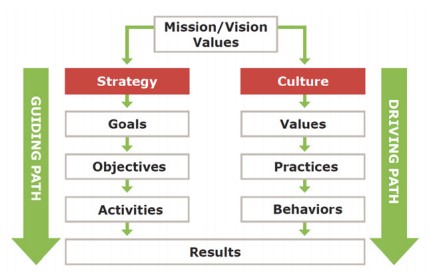I think that Ben puts it best AARP foundation in developing its Dashboard/Balance Scorecard, is missing an “onward focus” and mission impact. It’s completely internally focused because their actual mission is financial performance as their Dashboard/Balance Scorecard was almost completely driven from The AARP’s Dashboard. The intriguing question here is that who works for whom? If AARP is lobbying congress for money, as Ben indicated, why would they want to give it to the foundation? As we have learned in the class all semester long: that the mission drives the strategic planning process and hence driving the growth of the company. Rosie from United Way states it best: “what are we trying to do, why are we trying to do it, how are we going to do that, and who are we doing it for?” These questions are not clearly answered or defined in the AARP’s foundation Dashboard/Balance Scorecard.
When Shabnam was doing her analysis she stated: there needs to be better “Organization and Clarity” if this tool is going to be useful to drive the foundation’s mission. Oh, that’s another issue! Does the foundation really know what its mission is? Is it a charitable organization or actually a nonprofit? Is the foundation free to operate on its own or does the board and owners of AARP dictate how the foundation operates? When Shabnam was speaking I thought of the Susie B. Komen foundation where the sister and founder of Susie B. Komen had to step away from the nonprofit organization because her views and mission became the mission of the foundation while the organization lost track of what they were actually trying to accomplish for their customers.
It’s great that the foundation wants to align and to be integrated with AARP to optimize their resources and make the greatest impact. But to what ends? Ben mentioned that AARP/Foundation is targeting the “disproportionally [upper to] to wealthy middle class” when that is not their primary customer. The AARP Foundation was created in response to Congress passing laws to combat corruption in profit organizations such as AARP so the grants and funds would get to the people as intended; to make a social impact. Essentially, the AARP foundation was created as result of these policy changes to ensure AARP would still receive its money from the government. If AARP really was only established as a funding arm the purpose as to “why” a nonprofit is created and the policy changes from Congress are lost hence being a way around the law or a loophole for AARP to keep making the same amount of money.
Like Zerina said the strategic processes should have been done independently. The strategic planning team after spending several months going through a planning process just got lazy and didn’t take the time to “assess, reassess, and reevaluate objectives.” It just “plugged and jugged, copied and pasted” their performance measures from AARP. This makes you wonder whether the foundation actually had control of this or was there a non-transparent directive from AARP. This seems to be a recent trend in business over the last 10 years to develop foundations or different parts of companies so the company can make more money, have tax write-offs, and protect themselves from litigation. As we learned in order for a strategic planning process to be successful and nonprofit’\s to have the greatest social impact, organizations need to focus on its MISSION and CUSTOMERS to drive its structure/culture.
– David

